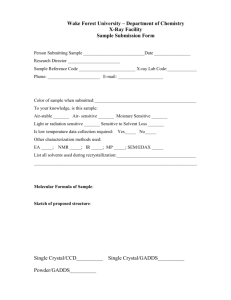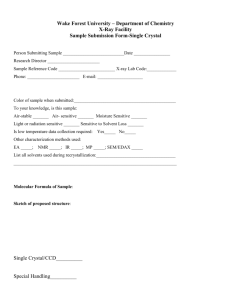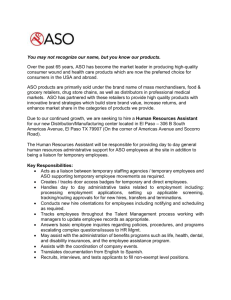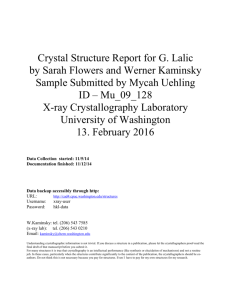OCTj11
advertisement
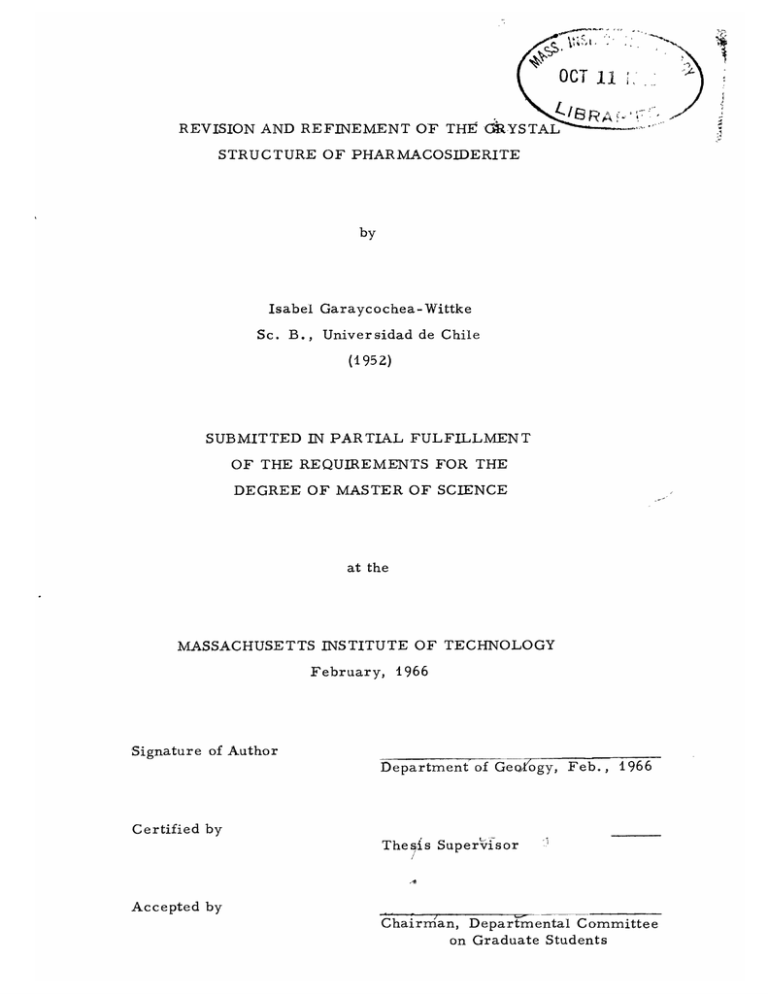
OCTj11 REVISION AND REFINEMENT OF THE (itYSTAL STRUCTURE OF PHARMACOSIDERITE by Isabel Garaycochea-Wittke Sc. B., Universidad de Chile (1952) SUBMITTED IN PARTIAL FULFILLMENT OF THE REQUIREMENTS FOR THE DEGREE OF MASTER OF SCIENCE at the MASSACHUSETTS INSTITUTE OF TECHNOLOGY February, 1966 Signature of Author Department of Geo-f'ogy, Feb., 1966 Certified by The ss Supervisor Accepted by Chairman, Departmental Committee on Graduate Students 0 38 Table of Contents Page Introduction 2 Cell 5 Space group 7 Number of formulas per cell and specific gravity 10 Intensity measurements 13 Absorption correction 14 Revision and refinement of Zemann's structure 15 Description and discussion of the structure 18 References 25 Appendix 28 List of Figures Figure 1. Space group P43m 2. Composite of the sections which contain maxima, taken 8 from the final electron-density function of the pharmacosiderite structure 3. The linkage of the AsO 20 tetrahedra to the cluster of four Fe(OH)303 octahedra in the pharmacosiderite structure 21 List of Tables Table Page 1. Comparison of the structures for pharmacosiderite proposed by HA!gele and Machatschki and by Zemann 4 2. Values of the lattice constant a of pharmacosiderite 6 3. General and special positions for the space group P43m with the origin at 43m 4. Chemical analyses of pharmacosiderite 5. Number of formulas (n) and calculated density (p c) for 9 11 pharmacosiderite 12 6. Zemann's structural data for pharmacosiderite 16 7. Final coordinates for the pharmacosiderite structure 19 8. Principal interatomic distances in the pharmacosiderite structure 24 Revision and refinement of the crystal structure of pharmacosiderite Isabel Garaycochea-Wittke Submitted to the Department of Geology on November 30, 1965, in partial fulfillment of the requirement for the degree of Master of Science. Abstract Pharmacosiderite is a hydrated iron arsenate mineral. A crystal structure for this compound was proposed by J. Zemann in 1948 based on the model of HAgele and Machatschki for the alumopharmacosiderite. The chemical formula proposed by Zemann was [ Fe 4 (OH)4 (AsO4 )] K. (6-7)H 2 0 with a cubic cell with a = 7. 93 , obtained from rotation photographs. Both a spectrochemical analysis of the sample used for this work, and the results from a Fourier refinement of Zemann's structure, showed ng4 potassium, so the f6rmula of our material is (6-7)H20. A cubic cell with a = 7. 99 _ was [ Fe4 (OH)4 (AsO4 ) 3 ] deduced from precession photographs. The cell constant determined from measurements on precision back-reflection Weissenberg photographs, and adjusted by least-squares refinement, gave a final The space group is P43m. 0. 0005 k value of a = 7. 9818 The structure determined here, essentially equivalent to Zemann's structure, consists of chains of AsO tetrahedra linked to complexes each of &e oxygen atoms of the tetraof 4 Fe(OH) 3 03 octahedra, hedron being shared by the corner of an Fe octahedron. An Fe atom has three AsO tetrahedra and three other Fe octahedra as neighbors. Each octahedron shares one edge formed by 2 OH radicals with each of the three other octahedra of the group. The distribution of the water molecules in the channels of the structure is the main difference between the structure proposed here and Zemann's structure. Starting with Zemann's coordinates, the discrepancy factor, R, changed from 26. 1% to 12. 3% after three cycles of Fourier refinement and seven cycles of least-squares refinement. Thesis Supervisor: Martin J. Buerger Title: Institute Professor, Professor of Mineralogy and Crystallography Acknowledgements I express my gratitude to Professor Martin J. Buerger, who proposed this problem, supervised my work and contributed to it with helpful suggestions and constructive criticism. I am indebted to the graduate students in the Department of Geology, particularly Mr. Wayne Dollase for their constant interest in this problem and their useful suggestions. Professor Clifford Frondel kindly provided the crystals utilized in this investiation. Mr. W. H. Blackburn from Cabot Spectro- chemistry Laboratory made a spectrochemical analysis of the sample. I also gratefully thank Dr. Hilda Cid-Dresdner who helped to give a final form to this work through many suggestions and discussions. Introduction Pharmacosiderite is a hydrated iron arsenate mineral which was first described by Proust in 1790. Since then, many chemical formulas have been assigned to this compound. Berzelius' chemical 2 analysis in 1824 suggested the composition Fe 8As6 02. 15H 0. Seventy-six years later Hartley the formula 2FeAsO . made new analyses and proposed Fe(0, K) 3 . 5H 2 0. However, in 1928 Heide4 reported that the potassium, instead of being a substituent of the hydrogen should take a place in the channels of the structure together with the zeolitic water. The first serious attempt to establish the crystal structure of pharmacosiderite, together with its real chemical formula, was made 5 in 1937 by HAgele and Machatschki 5 . They succeeded in synthesizing an Al analog of this compound as judged by the similarity of crystal shape, cell constants and general composition. Using powder photo- graphs, they determined an isometric cell for both compounds and suggested space group P43m as the symmetry. For their unit cell and measured densities, the cell should contain 1- of Hartley's formulas. Al 5 In consequence they suggested that the new formulas (AsO 4 ) 3 (OH) 6 . (6-8)H2 0 and Fe 5 (AsO4 ) 3 (OH) 6 . (6-8)H 2 0 should be accepted for alumopharmacosiderite and pharmacosiderite respectively. A structure based on these new formulas was also proposed by them; this structure consisted of a framework of AsO tetrahedra located on the center of the cell edges, linked to groups of 5Fe octahedra located at the cell's corners. The structure proposed by Hh!gele and Machatschki for alumopharmacosiderite and pharmacosiderite was re-examined in 1948 by Zemann6,7 with special regard to the iron compound. He confirmed the space group and obtained a similar value for the edge of the unit cell. However, he found poor agreement between computed and observed 3 intensities for Hagele's and Machatschkils structure and for several alternative models. This led him to the conclusion that a reinterpre- tation of the chemical analyses was necessary, and he showed that Hartley's analyses could be represented by the formula [Fe 4 (OH)4 (AsO 4 ) 3 ]K.(6-7)H 2 0. A structure based on this formula and on Hgele's and Machatschkils model gave a much better agreement between calculated and observed intensities. Table 1 gives a comparison of the Zemann's and the H&!gele and Machatschki structure of pharmacosiderite showing the equipoints of the space group P43m occupied on each of them. Zemannis structure for pharmacosiderite has been generally accepted as essentially correct, and this structure was assigned to a series of alkali germanate compounds studied from 1953-1956 by Nowotny and Wittman8 , 9 10 1. However, a detailed revision and refinement of this structure seemed desirable. A sample of pharmacosiderite from Cornwall, England, was kindly provided by Professor Clifford Frondel of Harvard University to be used in the present investigation. green colour, The crystals, of emerald- showed a cubic habit with diagonally striated faces; the [001] cleavage was imperfect to good. -I 4 Table 1 Comparison of the structures for pharmacosiderite proposed by HA!gele and Machatschki and by Zemann HAgele and Machatschki 5Fe(or 5A) in 3As 120 in Zemann 1(a) + 4(e) 4Fe in 4(e) 3(c) 3As in 3(c) in 12(i) 120 in 12(i) in 4(e) H 20 molecules in the 4(H 2 0) in 4(e) channels of the structure, 3(H 20) in 3(c) 6(OH) in 6(f) positions not specified. 4(OH) 5 Cell HY!gele and Machatschki's studies of pharmacosiderite and synthetic alumopharmacosiderite5 were based on a cubic cell for both compounds with lattice constants of 7. 96 _ and 7. 77 X respectively, obtained from powder photographs. were confirmed later by Zemann of 7. 93 X and 7. 76 X Their results who determined lattice constants for pharmacosiderite from Cornwall (England) and synthetic alumopharmacosiderite respectively. These results were obtained from rotation photographs taken with Fe and Cu radiations. For this work, a preliminary determination of the cell constant was made by means of precession photographs. Zero, first and 12 second-level a-axis and a zero-level [ 110] -axis precession photo- graphs taken with Mo radiation, rendered an a value of 7. 99 A , A refined value for a was obtained using the data from a precision back-reflection Weissenberg photograph taken with Fe radiation, according to the method described by Buerger 3. These data were used as input for the LCLSQ3 program written by Burnham14 for the IBM 7094 computer and submitted to 3 cycles of least-squares refinement. The final value of a was 7. 9818 ±0. 0005 A. Table 2 gives a resume of the values of pharamcosiderite's a constant as obtained by the different authors. Table 2 Values of the lattice constant a of pharmacosiderite Author Method HA'gele and Machats chki Powder photographs 7. 96 _R Zemann Rotation photographs 7. 93 X Precession photographs 7. 99 k This work Back-reflection Weissen- 7. 9816 berg photograph + least squares refinement 0.0005 X 7 Space group HA!gele and Machatschki5 and Zemann7 assigned the structure of pharmacosiderite to space group T d = P43m. This result was d obtained on the basis of morphology observations that suggested the macrosymmetry Td = photographs, 4 3m, the lack of systematic absences in the the Laue symmetry of 0h = m3m, and a primitive cell. This symmetry was confirmed in the present work by means of precession photographs. Of the three possible space groups P43, Pm3m and P43m compatible with the photographs, the last one was chosen in agreement with the arguments of previous investigators. It must be noted, however, that Hocart15 reported that observations of pharmacosiderite crystals under polarized light showed that the crystals are pseudo cubic, of monoclinic symmetry, and are twinned on the (119) pseudosymmetry planes. Nevertheless, Zemann specifically looked for intermediate spots in the photograp hs which could be interpreted as doubling of the cell edge, or twinning, and he was unable to find them. Figure 1 shows the symmetry elements16 of the space group P43m. Coordinates for general and special positions17 are shown in Table 3. '.lk. % - - (After M.J. Buerger o -. - o Table 3 General and special positions for the space group P43m with the origin at 43m Rank and designation of equivalent position Point symmetry Coordinates of representative points x y m x x 2 1 mm xO mm 3m x x x 0 42m 42m 0 0 43m 43m 0 0 Number of formulas per cell and specific gravity The number n of formulas per cell for Zemann's chemical formula [Fe 4 (OH) 4 (AsO4)31 K. 7H 2 0, n = was computed using the relation , where: -24 V p = 508. 475 x 10 = 3 2.797 g/cm o 24 3 cm (with a = 7. 9816 A) 18 N = 0. 602 x 10 A = formula weight (Avogadro Number) Since, as shown in Table 4, the different chemical analyses did not agree in the presence of the K ion,the same calculation was repeated for the ideal formula Fe (GH)(AsO ) 3 7H 0. The agreement between pO and p c was also tested for 6 water molecules on both formulas proposed. The values obtained for n and p c are shown in Table 5. Table 4 Chemical analyses of pharmaco side rite Hartley Fe 03 Ideal (Zemann) Ideal II III 39.29 38.81 37.58 36. 5 38. 24 39.57 38.91 38.36 39.5 41.27 19.63 19.63 18.85 18.6 20.49 4.54 5.4 [Fe4 (OH)4 (AsO4 ) 3 K.7H 2 0 Fe4 (OH) 4 (AsO ) 3 . 7H 2 0 As 205+ 205 H20 K20 98.49% 97.35% 99. 33% 100.0% 100.00% - -----jW Table 5 Number of formulas (n) and calculated density (pc for pharmacosiderite 6H2 0 1.001 2.793 7H2 0 0.980 2.853 6H2 0 1.049 2.667 7H2 0 1.026 2.725 [Fe4 (OH)4 (AsO4 ) 3 K with [ Fe4 (OH) 4 (AsO4)31 with Intensity measurements A single crystal of dimensions 0. 126 x 0. 140 x 0. 164 mm was used for the intensity measurements. It was first oriented optically and then by means of precession photographs. Before starting the collection of the intensities the correct orientation of the crystal on the diffractometer was checked according to Wuensch's method by recording on a small film the reflections 400, 400, 040, and 040. The three-dimensional set of intensities was obtained with a single-crystal diffractometer based on equi-inclination geometry. An argon-filled proportional counter was employed as detector associated with Norelco electronic equipment which included pulseheight analysis circuitry. Cu radiation with Ni filter was used, and the generator was stabilized at 35 kV and 15 mA. The equi-inclination angles T and cp and the angle 0 were determined using the DFSET 4 program written by Prewitt20, 21 A total of 121 reflections were recorded, corresponding to levels 0 to 9. In order to keep the measurements within the range of linearity of the counter the 30 strongest reflections, which presented a peak intensity larger than 650 count/sec, were measured an using aluminum sheet 0. 211 mm thick as an absorber. The transmission factor of the Al sheet was obtained approximately by measuring the intensity with and without the absorber in 10 moderately strong reflections. An exact determination of the transmission factor was not intended; instead, in the least-squares refinement, two different scale factors were assigned to the reflections measured with the absorber and without it. I Counter-intensity data for each reflection consisted of the scan count (i. e., total number of counts while the crystal was rotated through the maxima, from a position g4 > 0 (hk1))and fixed-time 14 background counts for the positions and(P. d The integrated intensities were computed using the relationship: BB+B 1+ B2 E =s I 2 T e b where: I = integrated intensity E = scan counts B = background counts at the position B = 2 T b= T = e s = 'pj background counts at the position 9 fixed time of background counting peak counting time scale-factor. Integrated intensities and Lorentz-polarization correction 22 were computed with the FINTE 2 program written by Onken Absorption correction Since the crystal used on intensity measurements had the shape of a parallelopiped, the transmission factor for each integrated intensity was computed by means of the GNABS program written by 14 . This program makes a general absorption correction Burnham for the equi-inclination Weissenberg geometry for a crystal with plane faces (non-special shape) provided no reentrant angles are present. The computed linear absorption factor and for the CuKa radiation was 315 cm . ± for this crystal -U Revision and refinement of Zemann's structure Zemann proposed a structure for pharmacosiderite based on the model of HA!gele and Machatschki5 for the alumo-pharmacosiderite. The atomic coordinates for this model are given in Table 6. To test the correctness of Zemanns structure, his atomic coordinates (which did not include positions for the K ions) together with halfionized f values23 for Fe, As and 0, and individual isotropic tempera- ture factors, were submitted to least-squares refinement. The refinement was performed on an IBM 7094 computer, and the SFLSQ 3 program written by Prewitt21 was used. The initial values of the isotropic temperature factors in k 2 units were 0.5 for As, 0.5 for Fe, and 0. 6 for oxygen. Two scale factors were included in the calculation (which distinguished between reflections measured with and without the Al abosrber) and were the only parameters allowed to vary during the first 2 cycles of refinement. No rejection test was included and all reflections were assigned a unit weight. The weighted R factor for Zemann's structure of pharmacosiderite without a K ion was at the end of these two cycles of refinement 26. 1%, the discrepancy factor R being defined as: unweighted R I F 1 - IF I1 o C ZIFI 0 Ew(I F I - JF J)2 a weighted r.m. s R 0 In order to locate the position of the K ion that Zemann predicted should be placed in the channels of the structure, a threedimensional electron-density function pl(xyz) and a three-dimensional difference synthe sis map A p1 (xyz) were computed using the MIFR 2 -U------ Table 6 Zemann's structural data for pharmacosiderite Atom Equipoint As Symmetry Coordinates 42m -100 Coordinate values Fe 4e 3m xxx x = 0. 131 OH 4e 3m xxx x = 0. 875 12i m xxz x = 0. 15 Z 0. 375 x =0. 653 H20 (I) H 2 O (II) 3m xxx 42m 011 17 program2l. The signs of the structure-factor calculation for which R = 26. 1% were used in combination with the IF I values. Both the electron-density map and the difference-synthesis map agreed on two interesting results: (a) There was no peak which could be identified with the K ion. (b) There was no atom in the position assigned by Zemann to the molecule H 2 O (UI). At this stage, a sample of pharmacosiderite was sent to the Cabot Spectrochemistry Laboratory for a spectrochemical analysis in order to test the presence of either K or Na ions. This analysis showed only traces of K and Na; therefore, the formula for the . (6-7)H 20. compound appears to be [Fe4 (OH)4 AsO 4 ) 3 In order to have a new conservative start, a three-dimensional electron-density function p 2 based on the signs of the As and Fe atoms only was calculated. This electron-density map showed, in addition to the expected peaks of Fe and As, peaks near the locations predicted by Zemann for the 0, OH and H 20 (I). These positions, together with those of Fe and As, were submitted to a structure-factor calculation, and the signs determined in this way were used to form a new threedimensional electron-density map p(xyz). at 0. 2, 0. 5, oxygen peak. This showed a new maximum 0. 5 having a height of about one-third the height of the This equipoint, of symmetry mm, corresponds to the special position 6 g. Since, according to the chemical formula, we need to put three water molecules in this position, H 2 0 (U1) must be statistically distributed, with multiplicity , at this location. When the atomic coordinates obtained from p 3 were submitted for a structure-factor calculation, a weighted R of 21. 8% was obtained. Four cycles of refinement, varying atomic coordinates and scale factors, gave an R value of 16. 6%, and three additional cycles allowing also the isotropic temperature coefficients to vary, yielded a final -H 18 R value of 12. 3%. The signs from the last structure-factor calculation were used to compute a final three-dimensional electron-density function and a three-dimensional difference map. The atomic coordinates and temperature coefficients, corresponding to the weighted R of 12.3%, are listed in Table 7. A composite of sections from the final electron-density function which contain maxima is shown in Fig. 2. Description and discussion of the structure The final arrangement of atoms in the structure corresponds basically to the structure given by Zemann . AsO complexes of four Fe(OH) 3 0 3 tetrahedra and octahedra (surrounding the origin) form chains along the cell edges. The As of each AsO is located in the center of a cell's edge, tetrahedron each of the oxygen atoms of the tetrahedron being shared by the corner of an Fe octahedron. An Fe atom has three AsO neighbours. Each Fe(OH) 3 0 tetrahedra and three other Fe octahedra as 3 octahedron shares one edge formed by two OH radicals with each of the three other octahedra of the group (Fig. 3). The four H 20 (I) water molecules are located in the special position x x x with x = 0. 10 instead of x = 0 as given by Zemann. The large channels are filled with water molecules in the way proposed by Zemann who also thought that these channels could include, besides positive ions, possibly K , Na or Fe It is useful to compare this structure with the structure of the series of alkali germanates M 3HGe7 0 164H 20, where M stands for Li, Na, K, NH , Rb, Cs, Ag or T1, given by Nowotny and 8, 9, 10 . They assigned to these compounds a structure Wittmann ' similar to Zemann's pharmacosiderite. Three of the seven Ge Table 7 Final coordinates for the pharmacosiderite structure Atom Z emann This work As 0 0 2.07 Fe 131 131 131 0.142 0.142 0.142 1.44 0.001 0.001 0.001 OH 875 875 875 0.890 0.890 0.890 4.24 0.006 0.006 0.006 0 125 125 375 124 124 387 99 003 003 004 0.653 0.653 0.653 683 683 683 99 0.008 0.008 0.008 H 2 O (I) H 0(11) 2 0. 10 1 2 6. 52 0. 02 Fig. 2. Coimposite of the sections which contain maxima taken from the final electron- density f-unction of the pharmacosiderite structure. h~7 QJ/z Fig.3. tetrahedra to the four The linkage of the AsO Pe(OH) 0 octahedra cluster in the pharmaceside3 a rite structure. 22 atoms take the tetrahedrally coordinated site of the As atom in pharmacosiderite,and the other four Ge atoms take the octahedrally 4H 0, the three Li In Li HGe 0 23' 7 16' 3 3 atoms are distributed statistically, - Li at 0 -4 and - Li at x coordinated site of the Fe atom. with x = that is, they would take the place of some of pharmacosi6' derite's water molecules in the channels of the structure. -, The final three-dimensional electron-density map p(xyz) and the final difference-synthesis map A p(xyz) are given in the Appendix. The electron-density map shows no additional peaks that could be interpreted as extra atoms in the structure. which appears on section x = 0 with a height The only important peak, 4 of an oxygen atom, is too close to the Fe atom on section 4 to be a possible atom. However, there is an important anomaly observed on the electrondensity map: the height of the water molecules H 20 (I) and H 2 0 (II) are not comparable to the average height of the oxygen atoms. is fact the height of H20 (I)0() 2 - In the height of an oxygen atom, and the height of H 0 (II) is only 1 of an oxygen peak. H 2 0 (II)was expected 262 of an oxygen since three water molecules to have a height of about 4 fill six equivalent positions. In order to interpret this low peak height as the water molecules being misplaced, negative peaks should be found in the corresponding locations of the difference synthesis map, which is not the case. The A p map is practically flat at the locations assigned to H 20 (I) and H 0(11). On the other hand, the temperature factor of both water molecules are too high, as shown in Table 7, and with such temperature coefficients the peak height 25 in the p(xyz) map is expected to be much lower than the normal This is confirmed by the fact that, at an R factor of 16.6 %, before starting the refinement of the temperature coefficients, the height of H2 0 (1) on an electron-density map was equal to a normal oxygen of an oxygen. height, and the height of H 2 0 (II) was the expected All these facts point out that what should have been adjusted was not the temperature coefficients but the multiplicity of the water molecules at the positions indicated. Since the adjustment of the para- meters was left to the least-squares refinement program, and the multiplicity was not allowed to change, the program changed the parameter whose role was closest to the multiplicity factor, that is, the temperature coefficients. It is possible then, that further refinement of the structure, taking these facts into account, would indicate a statistical distribution of the water molecules, giving a smaller number of molecules to the positions assigned to waters I and II. The remaining water molecules would possibly go to a position such as 0 - . Even if this position does not show a peak on the electron-density map, it shows a maximum on the A p map. The height of the maximum on the A p map is about half the height of the peak representing the H 2O(I) water molecule on the p map. The principal interatomic distances of the structure as computed from the final atomic coordinates are listed in Table 8. Distances corresponding to the AsO tetrahedra and to the Fe(OH) 03 octahedra are in good agreement with previous publications 2 6 ,27,h,930 Table 8 Principal interatomic distances in the pharmacosiderite structure Distance Multiplicity of the distance AsO tetrahedron Fe(OH) 3 0 3 octahedron Minimum cation-cation distances As - 0 1.66 R 0-0 2.80 0-0 2.68 Fe - 0 2.06 Fe - OH 2.04 DH - OH 2.48 0 - OH 2.89 0- OH 3.97 0-0 2.97 As - Fe 3.28 Fe - Fe 3.21 25 References 1. Proust. Fer mineralise par l'acide arsenique. Ann. Chem. 1 (1790) 195 (Taken from reference 18). 2. Berzelius. Akad. Hand. Stockholm (1824) 354. (Taken from reference 7). l/ 3. Uber die Zusammensetzung der natUrlichen E. G. J. Hartley. Arsenate und Phosphate. Z. Kristallogr. 32 (1900) 220-226. It 4. F. Heide. III. Uber eine hydrothermale Paragenesis von Quarz und Arsenmineralien in ver&nderten Quarzporphyr vom Sauback i.V. und Uber einige Eigenschaften des Pharmakosiderits und des Symplesits. 5. G. HAgele and F. Z. Kristallogr. 67 (1928) 33-90. Machatschki. Syntheses des Alumopharma- kosiderits; Formel und Struktur des Pharmakosiderits. Fort. Min. 21 (1937) 77. P/ 6. J., Zemann. Uber die Struktur des Pharmakosiderits. Experientia 3 (1947) 452. 7. J. Zemann. Formel und Strukturtyp des Pharmakosiderits. Tsch. Min. Pet. Mit. 1 (948) 1-13. 8. H. Nowotny and A. Wittmann. 9. H. Nowotny and A. Wittmann. Alkaligermanate vom Typ MH 3Ge2 06' Monatsh. f. Chemie 84 (1953) 701-704. Zeolithische Alkaligermanate. Monatsh. f. Chemie 85 (1954) 558-574. 10. A. Wittmann and H. Nowotny. einwerligen Kationen. 11. J. Zemann. Uber zeolithische Germanate mit Monatsh. f. Chemie 87 (1956) 654-661. Isotypie zwischen Pharmakosiderit und geolithischen Germanaten. 12. Martin J. Buerger. Acta Cryst. 12 (1959) 252. The Precession Method (John Wiley and Sons, 26 Inc.) 1964. 13. X-Ray Crystallography (John Wiley and Sons, Martin J. Buerger. Inc.)1958. 14. The structures and crystal chemistry of Charles W. Burnham. the aluminum- silicate minerals. Ph.D. thesis (1961) Mass. Inst. of Technology, Cambridge, Mass. 15. Contribution a l'Etude de quelques cristaux a Raymond Hocart. anomalies optiques. Bull. Soc. franc. Miner. Crist. 57 (1934) 5-127, 16. Elementary Crystallography (John Wiley and Martin J. Buerger. Sons, Inc.) 1956, p. 414. 17. International Tables for X-ray Crystallography. (Birmingham, The Kynoch Press) 1 (1952) 324. 18. Palache, Berman and Frondel. Dana's System of Mineralogy. (John Wiley and Sons, Inc.) 2 (1951) 995-997. Private communication. 19. B. W. Weunsch. 20. Charles T. Prewitt. The parameters T and cpfor equi-inclination,, with application to the single-crystal counter diffractometer. Z. Kristallogr. 21. C. T. Prewitt. 114 (1960) 355-360. Structures and crystal chemistry of wollastonite and pectolite. Ph.D. thesis (1962) Mass. Inst. of Technology, Cambridge, Mass. 22. H. Onken. FINTE 2. x-ray analysis. Manual for some computer programs for Mass. Inst. of Technology, Cambridge, Mass. 1964. 23. International Tables for X-ray Crystallography. The Kynoch Press) 3 (1962) 204. (Birmingham: 27 24. William G. Sly and David P. Shoemaker. MIFR 2: two and three- dimensional crystallographic Fourier summation program for the IBM 7094 computer (1960). 25. Martin J. Buerger. Crystal-structure analysis. (John Wiley and Sons, Inc.) 1960. 26. H. Mori and T. Ito. The structure of vivianite and symplesite. Acta Cryst. 3 (1950) 1-6. 27. T. Ito and H. Mori. The crystal structure of ludlamite. Acta Cryst. 4 (1951) 412-416. 28. Charles T. Prewitt and M. J. Buerger. The crystal structure of cahnite, Ca 2 BAsO4 (OH) . Am. Min. 46 (1961) 1077-1085. 29. G. Giuseppetti, H. Coda, F. Mazzi and C. Tadini. La struttura cristallina della liroconite Cu 2 A1 [(As, P) 0 4 (OH) 4 1 .4H 2 0. Min. 31 (1962) 19-42. 30. Giuseppe Giuseppetti. La struttura cristallina dell' eucreite Cu 2(AsO )(OH). 3H 20. Per. Min. 32 (1963) 131-156. Per. 28 Appendix Sixteen sections of the electron-density map p(xyz) and the sexteen sections of the difference synthesis map A p(xyz) corresponding to an R of 12. 3 % are shown. For the computations, the cell's edge was divided into 30 parts, so the set of maps represents one quarter of the unit cell. In both sets of sections the positive contours have been drawn with full line, the zero contour with a dashed line and the dotted line represents the negative contours. arbitrary but equal intervals. The contours have been drawn at Only a few contours of the Fe and As atoms have been represented, but the actual relation of the average Fe peak height to the average 0 peak height is approximately 1300/300 and this relation is 1700/300 for an As peak compared to an 0 peak. Each contour on the p(xyz) map corresponds to five contours on the A p(xyz) map. The axes were chosen as follows: x axis, normal to the sheet; y axis, parallel to the vertical direction; and z axis, parallel to the horizontal direction. The atomic positions are indicated by a cross on the section closest to the corresponding x coordinate. the sections containing the atoms are: In particular, x = 0, As atom; x 3/30, an OH radical and the oxygen from the H 20 (II) molecule; x = 4/30, Fe atom and two oxygen atoms; x = 9/30, the oxygen from the H 2 (I) water molecule; and x = 12/30, the third oxygen atom of the asymmetric unit. Only half of the specific sections (Oyz) and ( lyz) for p and A p are shown, since these sections present a mirror symmetry plane at 00- parallel to the y axis. N 0-- 0 dIN C -lee' ol d ICA 0 % tt. 6. I-..- - - / - -. *. -of\ 4% le / \ . -. / .0p4o, o o - ........... - .\ .......... 4 4 - 0 / / / 4----- NI -4 - I 4-.--- I I I I I I I * * I I .4 .4..- .4.4 .----- -4 . - I '4 1 4. / i I -, - .00 64 -% - . i 6% -- 4.--- -. 0 " .4 - .4 . 1%1% - 4 \ ~*%. loo - ., ~1 % 1% % -%- - '4 I .4/ O - ? (.i y 30 0 -7 #4#4 ~I / .0 d%1 - - S/I .m.% I I %.~ , - - W,, I - #4 / 1 I * I I I d I '4 I . I dool - I #4 .. 4.. #4 I 'I I I I '4 a I 4. - - - I I * I * I I 4, '4 I 4. #4 4, 4, -. I 44 -'4 - '4 .4 4. 4, 4, '4 I '4 1 I 1 4, #4 I i I I ' I I '4 Ole, / 4 4, ~ 1~~~~ / I I 4. 4, 1 I '4 4. '4 *4 4, 44 '4 '4' '4' I I 4, 4, 4, I a 4 4, 4, I I '4 I * * I '4 I 1 I 4. 4. .4 C at" ~% , p(I-yz 3* 0 / I I / '4 '4 / - - / - % ' '4 I I / I I - '4 I I * )'. I I I I $ / / - I % 1% I - - '4 I - '4. a / . I *4* I I I I ' I I '4 - - I - - I * a '4 1~ ~ '4 '4 '4 '4 '4 I'4 I I '4 I ~*% %.*~ '4 I 1' a- - I '4 I. '4 / ,- -l 41' % '4 I I I I I '4. I 41. / '4 '4.- S- ~*41 / I '4 #4 a / I I / I I r40apa I I '4 I 2 '4 I '4 I I I '4 '4 '4 '4 '4 '4 I I '4 , I I ' '4 9 I .--- - '4 '4 '4 '4 % / '4 I IN '41 '4 '4 '4 1 '4 '4 - , - - ~L) I -#4 / I I ot ?(f30 y z) 0 -4 4, \ I 4, '4 'I '.4- 44 4, ' ~ I ' I I I I 4, '4, 4. -4 ol % / 4, do - , - - 4, Qb % 4, I I '4 I ~- "4 I 4. I 4, I / ,~"0 4, 4, .4% I I / / F I - I I de 1 / I - / 4, I I I 4, I 4. 4, 4. 4, / I 4, / / I I .ei do #00 do 'I %. 4, I 4,, / I - I I / I / I, I I~0 44~~~~ - I * I 44, - - 4, I / a te I 4, go k4 %W- I '4 .4 00- 4, 4. 9.. ".. . 0- - '4 -4 -4 -4 % - 44 4, I I 4% 4, 'op 4%-4- - 1 I 4,, 4,~. I - 4, 4, 4, '~ 4 4.- .1 - p(- yz) C I, I / 9' 00- ap % #1 9' % I / 9' 5 .0 00 "o -4 I I / / I I' 19' I t I 4' 44% I .1 I I I I - 44 - - ~ 44 9' 44 - 44 44 44 44 '-44 1 1 1 9' 9' 4' 9' I 9' 9' 9' o' %. 9' 9' I 9' '4 - 9' , I IL I 4. ~44 9' 9' - - 9' '~444' .4 9. j I I - 9' dO' dOp 9' 4' 4' - -1- - -%I- - -00 I lop .0 -o / f % . - -w- W% 3(Iy) 0 , I I I I 'I I, / I I I - I I .4 I I I -- 10 .4 I - I -, - I I I 4. 4. / I 1 .4 .4 .4 .4 .4 I .4 I I 4% .4 I / I - -- 4. - .4 .4 / '.4 .4 .4 I - - .4 I I I '4 4. I. .4p do I I I I I - / .4 / '.4 4.'4 .4 '4 l~ I I j .4 4. ,~ ~.4 I 4.4. .4 4~ S I I / 4--. I - ~doe i .4 I %- I I / I I I, , op / / "- - 1 . I II 4. I I I -'4. - .4 . .4 .4 . .0 W " .4 I--- - / I - / I I I 2 , . p I 4. d Cl 0 I I Id '4, , S -/I ftb 100 ' .9 .4 -. % I/ 41% e I I .4 / .4 I I '4 .4.4 S I .4 .4 / .4 .4 I .4 .4 .4 .4 I .4 .4.4 .4 I I .4 I I .4 I .4 .4 / .4 %%1%%- "-.4 ' I .4 '---.4 .44 ~ 44~/ .4 '4 .4 I* / '.4 '4.. ,"* .4 ~.4 .4 .4 I .4 - 4--., %. ~.4 .4 '4 I I .4 f p N4,.0 "4 .4 -% 4% %- .4--'- .4 .4 I I .4 I I I *1 d~c~ dlNq a di4 (1yz) 30 0 U 9' / I V 9' I 9, -'4 '4 - 9' 9, I , 9' 9' I I I I I I OF I I I j I 9' % - / doe.%% II Z'O - V o9' df % fO d9p 9I- ~.. 9' 9' / .-- d% I - - % I / I I 'I I - %~ I 910 '4' 1~. / I I I I' / '4 I I .4 9' '-'4 / I '4 V p.. *% - 9' 9' 9' -~. OF NI 00 a (L2. yz 0 * * I I I I I OF4 I lo I 4, 4, 4. I / / 4, 4, 44 I I N / -- 44 2 4,, I .4 / .4 4, 4' I - 4. 4' - - '4' - I 4, 4, V. 4' I .4 4, - - 'V. I I -- / 4, 1 *46 - I I - '4 4--.- V. '.4 .0 I - I V. 4, 4, 4, I I I / 4, I / / / V. / l .4 .4 -- 4, I 4, e 4' / 4. N I I I 4. 4 V. '04 II 4,* 4.0 4, I ?(9-Yz) \30 0, 0 #. .4 \ I '4 4, '4 I I ~ % , I '4 "4 *1 / I / / I % %-%d. --- 44 .4 .- - - op- %% I%- '4 .4% '4 '4 I Pt I Pt I I I '4 4.. I 44 I 44% p. 44 4-4- - - I '4 '4 --- I -4--. I I '4 I .4 r '4 -. 44 444., (I I - ~ p. 4. .4. 4, - P.. 44% - ~ - / 4, I , 4% I p. Pt '4 '4--., '4 Pt Pt I / / / - I p. .4. - -- -, \ 'I / / 44 I '4 I I 4, '4 '4 I / -- / 4, -4--- I V I. \4 z 44 I' 444----- '4 - I, 4-~ dl / I / 444 0 d1C ?(PZ) 0~ a j I I I -- - - I - / I I I I I I I I I *% I ,,/~Q ,2 A ~.. ----- I I I I I I I I - % ,~ U '.- I I / - I I I I I I I I I I - - % I - - I I I I I I I I I I I I I I I I I I I g I I I I a I I I / I I I II I 1 - - I I I I % / / / I /- I I I / I £ I 2~ -~ / I I I / O d 0 *.* -.. * * * I .1 I I I ~' 4 1% # 1~~ ' dlop 400 '-4 0 N.-, 'S * * * I U. I 6 . 'S OF0 -,/ / * * . I I - / 1*** I I. I... I. . - %%% .. * * * * I I I U I ) dop 0 d(IC *4 I* 4 4% * -. - - - / -- ... % . i% .. I li 4% - * * 4% I I I I I* 4%.e .. *% ' I \ 4 I ' - I IV4. d..* U ~1 I I 4% I 4 I I 4F / I I / I I 4% - I. - ~ 5** N 0 rc~fri I a l*Ieft d cIZ %I F44 4. , lb* * - 4 * 40 %w. .4. *. e. * %t a o /. %% *. t% * *- * I -* * -- 4 I -- 4* 4. N <t.00 N 011- N *.II a?(! YZ) 0 I \f 4. I I -* / 5,,; * I - ~% I * I * op 9 I * S 9. .4 9'9.9' * / * . I 4. 4. 9 op I.-- / \ I I % I a I I I I I * * ~-.*. I, * / * 4. * / - 9% S I I 9% 9. 9. 9, 9% 9, 9. I , / I I I - 9, 4. 4.. Of aw 9% 4. / 9 I a 9' 9' 9' 9, I 9, 9' / 9% I 9..- *00- 9. 9, do d1b" 4. 4. 4. ~ %.. %% 9' 9% 9, S 9, * Os % 9. 9. S S S S / 9% H C dieC4 AV(3 y 2) Ct0 -m -% .. I I dwI *., % I 'amp - 'I qft % -%*%*,, 0 -'4, I '1 , I j V ji \. I ~V I V I * V .* *e -' .s a , V . *. - - /9 % .- , - Vr 60 I * J * I I 4, I V I I oft 4ft ft * *....* I V Ia * 9 * * I I ap 4. 4I I I . '9 * S . * V '4 '4 I I / "-a& qb V * I . V '4 I / V * I * I a * I 'I '4 -*e *. I I U. * '4 '4 * '4 .e I I . V . 0 I a * I . I '9 '9 I I 4,* I 9*~~' V 2 I * / F V I I 4% I I. V '9 I 4, I * .. I I I 9 I - V '9 - 1 I - (1Z 0 ,/ / / - / d / - / *..l * I I I I 1 / I I I' '1 * I %-. -,06 J I I I I o * I * / I I I / / - I d / I 1 I I / I / * / * *-. I I I' '%~-,-, -*% - - - / I I ' I' ~% -- -- - I I I I I * / I 'I I / I * * * I I I -- - *1 I I . 2d -%-4p. I I I I I I.. I - 'p. _ I / 1.* 'I * * / I I I . -- *% I I I I I - I I % I / / I I cc C I I I I I I d - - / - , I I 0 AP (N Y 0 - % 4. 4. I I C .4 .4 .4 4-o lop 00 * -4 a 04 . .4... .4 I 4. 4. bE .4 I I ~ I .4 I .4 I * I I I 4'.- - ----. I 4.. 4. 4, -. / I 4. 4. .4'-- 44* ~ / 4% / 4. 9. '4 4, '4 4, I 9% I 4. 'I 9. 4, * / 4, .444 '.4 9. 4-o I 40 9. I / 1 -- 4. '4'4 4. 4. 44 4.~'. I 4% I / Iw - I .4 '4% 4. / / .4. 4. - - ~ --- 4.. 9, 4. '4 .w W 60 '4 4- -- q% I '4. '4 4%--..,- I / I I I I 2 . -,-Op4 Ap y z) I % OW - pw % %- 4w loo I '4 -sena s V - spamu-4 I*4 am.m... . a I . I ** '* ** .' * e 4' S I o V * I S I 9 4i./ V .9 e . . dod -S I .. -O 4' I * * 4. '4% I .9 I a a e I I *. .. * am am *., I I e - *o OP.ap 4. I I * * U * '4" '4 S U S '4 S I I I I . 9. e4 e' , I U U I I U /10 404 * . . .0 d
